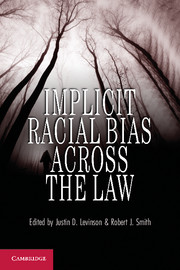Book contents
- Frontmatter
- Contents
- Contributors
- Acknowledgments
- Implicit Racial Bias Across the Law
- Introduction Racial Disparities, Social Science, and the Legal System
- 1 Implicit Racial Bias
- 2 Property Law
- 3 Criminal Law
- 4 Torts
- 5 Employment Law
- 6 Health Law
- 7 Education Law
- 8 Communications Law
- 9 Corporations Law
- 10 Tax Law
- 11 Intellectual Property
- 12 Environmental Law
- 13 Federal Indian Law
- 14 Capital Punishment
- 15 Reparations Law
- Index
- References
11 - Intellectual Property
Implicit Racial and Gender Bias in Right of Publicity Cases and Intellectual Property Law Generally
Published online by Cambridge University Press: 05 June 2012
- Frontmatter
- Contents
- Contributors
- Acknowledgments
- Implicit Racial Bias Across the Law
- Introduction Racial Disparities, Social Science, and the Legal System
- 1 Implicit Racial Bias
- 2 Property Law
- 3 Criminal Law
- 4 Torts
- 5 Employment Law
- 6 Health Law
- 7 Education Law
- 8 Communications Law
- 9 Corporations Law
- 10 Tax Law
- 11 Intellectual Property
- 12 Environmental Law
- 13 Federal Indian Law
- 14 Capital Punishment
- 15 Reparations Law
- Index
- References
Summary
Connecting Race and Gender to Intellectual Property Law
Intellectual property (IP) rights have a tremendous impact on the production, control, and direction of culture and identity in American society. The dominant players in the entertainment and advertising industries seek to control wealth and to profit from the ability to influence the direction of culture and identity in American society; for example, institutional copyright holders are concerned with maintaining the status quo that favors their interests over those who have been historically disenfranchised and oppressed by the unauthorized and uncompensated exploitation of their personas and identities. These dominant players, the “haves,” continue to benefit from the head start they achieved as a result of their white privilege that afforded them the ability to serve as the architects of the current intellectual property law regime favoring print, broadcast, and digital media interests.
No longer is overt racism or sexism necessary to maintain the status quo in favor of institutional copyright holders; instead, two of the more pernicious influences on directing outcomes in intellectual property law cases are, first and foremost, the belief that American copyright law is superior to publicity rights law and, second, the unconscious deployment of highly subjective beliefs and stereotypes by decision-makers who are required to settle disputes between institutional copyright holders and disenfranchised publicity rights holders, many of whom are African American and women. These well-meaning decision-makers, practitioners, and even scholarly commentators are convinced that intellectual property law is immune from implicit race and gender bias. In an attempt to respond to the cacophonous claims that intellectual property protection and enforcement regimes in America are race neutral, this chapter presents the theory that implicit bias is present and operating in the intellectual property law sphere generally and in the right of publicity sector specifically. Understanding how implicit bias functions in intellectual property domains will allow us to address to what extent intellectual property law and its application can respond to the reality of implicit bias and then to accept the challenge of taking steps to address what forms of distributive justice are appropriate for rights holders whose social and economic interests have been marginalized, disenfranchised, and subordinated by unconscious biases permeating this sphere of law.
- Type
- Chapter
- Information
- Implicit Racial Bias across the Law , pp. 179 - 191Publisher: Cambridge University PressPrint publication year: 2012
References
- 2
- Cited by



